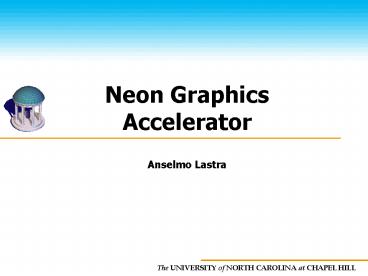Neon Graphics Accelerator PowerPoint PPT Presentation
1 / 30
Title: Neon Graphics Accelerator
1
Neon Graphics Accelerator
- Anselmo Lastra
2
History
- A proposed DEC product
- Never sold, as far as I know
- They were bought by COMPAQ
- Later HP
- Paper at 1998 Graphics Hardware
- Take into account that this was in the days of
3dfx Voodoo - Not too many sources of info on one-chip GPUs
- More detailed tech report
3
Rasterizer-Side Only
- Geometry processing on host
- A fast Alpha workstation
- Common on early PC products also
4
Performance
- Note the historical increase in performance
- Memory bandwidth
- Neon 3.2 GB/s, now about 40GB/s, gt10X more
- Fill
- Neon about 2M 50-pixel textured triangles,
100Mpixels/s - Now fill rates of 10 Gpixels/s
- Transform
- None, but 7M tris/s setup
- Now 800 Mverts/s
5
Block Diagram
6
Unified Memory
- They argue for single memory
- Common now, of course
- Can trade off one type for another
- Smaller FB More Texture
- Say that texturing can cause thrashing between
texels and color/Z - Is unified memory the best way to go?
7
Fragment Generator
- Each cycle generates one of
- Single textured fragment
- 2x2 square of z-buffered fragments with color
(64-bits data) - RGB alpha
- Z
- Fog intensity
- 8 fragments with 32-bit solid color (or stipple
pattern) - 32 8-bit 2D fragments
8
Texel Central
- More than just for textures
- Also frame buffer transfers go through here
- DMA to memory, Bit Blts
- Texture maps one fragment per clock
9
Fetch Before Z Compare
- Why?
- Pre-texture data approx. 350 bits
- Post texture 100 bits
- Couldnt afford more (and wider) queues to
texture map after z test - OpenGL requires z update after texturing
- Distributing textured fragments to memory
controller and then using only some would
complicate maintaining spatial coherence (?)
10
Texture Interpolation
- c is fraction of u, v, or the LOD
- They also added a table to implement separable
filters (See TR WRL-99-1)
http//www.hpl.hp.com/techreports/Compaq-DEC/WRL-9
9-1.html
11
Pixel Processors
- Eight of them
- One per memory controller
- Responsible for
- Z test
- Alpha
- Stencil
- Fog
- Blending
- Dithering
12
Arithmetic
- Make a point of doing correct math
- We ran into this on PixelFlow
- Reference Blinn, Two Wrongs Make a Right, CGA,
Nov 95 - Conversion
- Float to fixed pt.
- Fixed to float
13
Multiplication
- To see how this works, Blinn begins by converting
to FP, then doing multiplication - Product is
- or
- Scaling the 0.5,
- If s is a power of 2, like 16384, can use shifts
14
Color Multiplication
- Say were using 8-bit color, 0 to 255
- In order to represent 0, 1, the 255 is
equivalent to 1.0, and s 255 - So, to multiply a X b
- In hardware?
15
Blinn Says
16
Why?
- Division generates quotient j and remainder k
- The border cases of the remainder are 127 and 128
(no exact 0.5)
17
The Two Biases
- Bias of 128
- Bias of 127
18
Explanation
- Turns out bias must satisfy
- or
19
Implementation
- Dont want to divide by 255
- Attributes this trick to Alvy Ray Smith
20
Video Controller
- Always requests data from both bank A and B
- Memory controller chooses bank to maximize memory
throughput - Video controller can request data immediately
when reply will be late
21
Memory Controllers
- 8 separate memory controllers
- Each 32 bits wide
- 32 total 100MHz SDRAM chips
- SDRAMs can have up to 4 banks
- 23 address and control pins per controller
- Total of 440 pins for memory
22
Memory Controller
- Frame buffer partitioned across the 8
- Five request queues each
- Reads from Texel Central
- Read and Write from Pixel Processors
- A and B bank reads from video controller
- Chooses from among queues to minimize memory
cycle waste - Each controller has texture cache, 8 32-bit
texels, fully associative - Very small
23
Fragment Batches
- Batch of z comparisons and z/color writes
- Need to detect when two fragments belong to same
pixel - 8-way fully-associative overlap detector
- Detector terminates batch if incoming fragment
overlaps - Writes all data for terminated batch before
reading new
24
Interleaved Frame Buffer
- Checkerboard but rotated
- They suggest that 2x2 or 4x4 pixel batches would
be better - Would need more memory at controllers
25
Fragment Generation
- Chunked or tiled
- Already discussed this
26
Memory Usage (from slides)
27
Performance Counters
- Two 64-bit counters
- Programmable
- To decide what to count
- Not much detail provided
28
Chip
- To show how much area/function
- Lot of space devoted to MC
- Includes caches and request queues
29
Design Details
- They used C simulator
- Wrote a C to Verilog tool
- Developed some synthesis tools to help Synopsis
30
Technical Report
- More detail in Tech Report
- http//www.hpl.hp.com/techreports/Compaq-DEC/WRL-9
8-1.pdf - Might be useful for people implementing
particular parts of pipeline - Texture addressing and filtering, for example

